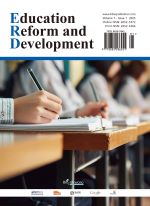An Exploration of the Application of the Traditional “Master-Apprentice System” in the Inheritance of Chinese Painting
Abstract
The traditional mentoring system has lasted for thousands of years in China’s fine arts education, which has trained a large number of artists and enabled China’s excellent traditional fine arts skills to be inherited and developed. However, with the development of modern education, the traditional mentoring system has been gradually replaced by other educational models due to its low efficiency. Today, when the inheritance of Chinese painting was re-examined, we can find the outstanding contribution of this traditional mentoring mode. It can be said that it is an indispensable talent training mode for the inheritance of Chinese painting. In this regard, this paper analyzes the traditional “mentoring system” in the inheritance of Chinese painting, discusses the teaching law of this mode, and hopes to find a complementary path with the modern education mode, to lay a solid foundation for promoting the inheritance of Chinese painting.
References
Wang Y, 2024, Research on Inheritance and Innovation of Chinese Painting under Traditional “Mentoring System.” Public Relations World, 2024(14): 34–36.
Chen H, Zhang J, 2010, A Brief Analysis of the Mode of Traditional Chinese Art Education “Passing from Father to Son, Teaching to Apprentice.” Journal of Kaifeng University, 24(3): 31–32.
Zhou J, 2009, Analysis on Mentoring Chinese Painting Education. Journal of Jiaozuo University, 23(2): 94–95.
Wu H, 2009, On the Gains and Losses of Traditional Chinese Art Education “Passing from Father to Son and Teaching Master to Apprentice.” Popular Literature and Art (Theory), 2009(2): 26–27.
Luo W, 2024, Research on the Application Strategy of Traditional Chinese Painting Techniques in Junior High School Art Education. Selected Chinese Loose-leaf Literature (Teaching and Research of Traditional Culture), 2024(7): 139–141.
Mei M, 2024, Thinking on the Integration of Excellent Chinese Traditional Culture and Chinese Painting Education. Beauty and Times (Middle), 2024(7): 87–89.
Mao Y, 2024, Based on the Development of National Culture Inheritance and Development of Primary School Art Traditional Chinese Painting Teaching Innovation Strategy. Primary School Students (The First Ten Days of the Month Issue), 2024(7): 91–93.
He Y, 2024, Understanding and Practice of Chinese Painting Improvement in Chengdu Area during the Anti-Japanese War—From a Debate around Xu Beihong in 1943. Fine Arts Observation, 2024(7): 59–65.
Feng N, 2024, Research on “Charm of Chinese Painting” in Primary School Art Based on Core Literacy. In: Beijing International Exchange Association. Proceedings of the Third Symposium on Educational Innovation and Experience Exchange in 2024, Railway School, Dongsheng District, Erdos City, Inner Mongolia, 206: 3.
Wang Y, 2024, Research on Inheritance and Innovation of Chinese Painting under Traditional “Mentoring System.” Public Relations World, 2024(14): 34–36.
Wang Y, 2023, Thoughts on Reforming the Teaching Mode of “Tutor System” of Chinese Painting. Fine Arts Literature, 2023(12): 74–76.
Ni W, 2024, Chinese Painting Teaching of Primary School Art Theme Unit from the Perspective of New Media. Parents, 2024(18): 143–145.
Dong Y, 2023, Research on the Integration and Innovation of Chinese Painting Elements and Modern Graphic Design. Toy World, 2023(3): 149–151.
He Y, 2024, Exploration on Teaching Reform of Chinese Painting for Fine Arts Majors in Colleges and Universities Based on Cultivation of Innovative Ability. Beauty and Times (Middle), 2024(6): 80–82.
Chen H, Zhou W, 2024, Curriculum Construction Promotes the Development of Number Intelligence and Enables the Creation of the Future—Exploration on the Educational Practice of “One Core and Two Wings, Number Intelligence Drive” in Gongle Primary School. Primary School Teaching and Learning Research, 2024(17): 30–31 + 34.

